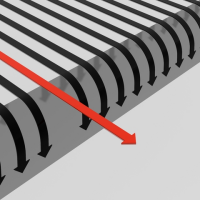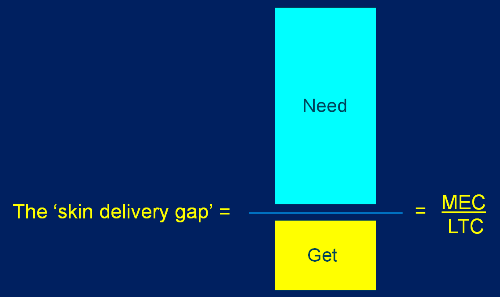 Regularly, we do clinical trials to assess whether the active ingredients or active pharmaceutical ingredients we work with are really active. We need to do this in vivo as we all know that not every molecule that has promising results in vitro will also perform in vivo. Why? Because the right molecule is not delivered to the right site at the right concentration for the correct period of time. Not only the intrinsic activity, but also its delivery needs to be optimized. The capability of a molecule to penetrate the skin is something like its melting point or any other physical parameter. It can be calculated via molecular modelling. But our industry is not linking the theoretical skin delivery to the clinical efficacy of a molecule. That is why I developed the Skin Delivery Gap calculation based on molecular modelling of physical chemical parameters of the penetrating active. It assumes, for instance, that your active is uniformly distributed over the skin (which may not be the case in real life) and your molecule is within the boundaries of current models that predict skin penetration of chemicals. Outside these boundaries, the prediction loses accuracy but is still useful as a rough indicator of the concentration that can be reached at the target site. Therefore, calculating the Skin Delivery Gap of your active helps you to predict whether you will get clinical efficacy or not before you do your trial.
Regularly, we do clinical trials to assess whether the active ingredients or active pharmaceutical ingredients we work with are really active. We need to do this in vivo as we all know that not every molecule that has promising results in vitro will also perform in vivo. Why? Because the right molecule is not delivered to the right site at the right concentration for the correct period of time. Not only the intrinsic activity, but also its delivery needs to be optimized. The capability of a molecule to penetrate the skin is something like its melting point or any other physical parameter. It can be calculated via molecular modelling. But our industry is not linking the theoretical skin delivery to the clinical efficacy of a molecule. That is why I developed the Skin Delivery Gap calculation based on molecular modelling of physical chemical parameters of the penetrating active. It assumes, for instance, that your active is uniformly distributed over the skin (which may not be the case in real life) and your molecule is within the boundaries of current models that predict skin penetration of chemicals. Outside these boundaries, the prediction loses accuracy but is still useful as a rough indicator of the concentration that can be reached at the target site. Therefore, calculating the Skin Delivery Gap of your active helps you to predict whether you will get clinical efficacy or not before you do your trial.
I want to know before I do my clinical that it is going to be successful. Can that be done?
A very logical question to ask. You've done all the in vitro work and all looks fine. Your latest active is really a very active molecule. You do a clinical study but there is no activity. Money is wasted. Management is not pleased. Maybe you did not optimize the skin delivery of your molecule (where the formulation concept of Formulating for Efficacy could help you (see elsewhere for an article on that topic)). Maybe your molecule could not be delivered in sufficient amounts to the target site. Then even an optimized formulation cannot deliver the molecule in sufficient amounts to reach the minimal effective concentration.
But how do I know whether I will reach the minimum effective concentration at my target site?
Via a series of calculations based on molecular modelling of skin penetration and some assumptions in pharmacokinetics, the concentration that you will get at your target site can be predicted. This concentration I call the Local Tissue Concentration (LTC). When I link this to the Minimum Effective Concentration (MEC) that you know from your in vitro experiments, I can calculate the so-called Skin Delivery Gap (SDG). The larger the SDG, the bigger your delivery (and therefore efficacy) problem. In that case, you need all kinds of clever delivery systems to overcome this gap to still deliver enough active ingredient at the site of action. If the SDG is very small, anyone can formulate your active. You can hardly go wrong with your formulation!

So, you calculate the Skin Delivery Gap for my molecule and then I know if it is going to work or not in vivo in a clinical study. Is that it?
Yes, that is it. But there is more. Because I calculate this as a ratio of the concentration that you need relative to what you get, I can even compare different active ingredients to pick the best one. If you have identified a series of, say, 20 new active ingredients that all are active but all at different concentrations at the target site, how do you currently identify the winner? Nowadays we simply select the one with the lowest minimal effective concentration as it is the most active one of the series. But if this one penetrates the skin with much more difficulty than the others, you may be better off using another one. The Skin Delivery Gap allows you to compare your active molecules on both parameters simultaneously: their intrinsic activity (via the minimum effective concentration) as well as their deliverability (via the local tissue concentration at the target site). Do not forget that the clinical efficacy of a molecule is determined by both the intrinsic activity of this molecule and its deliverability! Both need to be taken into account to predict whether your new molecule is going to be active or not.
So, by calculating this skin delivery gap for a series of new active ingredients, you allow me to pick the one with the highest probability of success?
Now you're getting it! I even dare to predict that the Skin Delivery Gap will soon become a sales tool for selling active ingredients. Customers will only want to have active ingredients with a low Skin Delivery Gap. Then their actives will be really active and they will not be selling hope in a bottle. Active ingredients suppliers can use Skin Delivery Gap calculations as a means to identify the most suitable candidate(s) to develop further. In fact, the Skin Delivery Gap calculates your probability of success with that ingredient, both as a supplier of this active and as a user of this active!
But if I now want to continue with a novel active with a wide Skin Delivery Gap, am I wasting my time and my company's money?
Possibly but not necessarily. Now we have to look at the size of the gap. If it is extremely wide, then entry via the skin is simply not an option or you need to use specific skin delivery systems like microneedles. In fact, I use the size of the Skin Delivery Gap to select the skin delivery system that I need to use. On the other hand, if the Skin Delivery Gap is small but not too small, you can use specific formulation approaches to still deliver the active. Formulating for Efficacy is one of such formulation approaches. Adjuvants is another. See elsewhere for descriptions of these formulation concepts. But the whole point of calculating the Skin Delivery Gap is that you will know beforehand how immense or small your job will be when you decide to continue with that particular molecule... It may therefore serve as a go/no-go decision point.
Powerful stuff, so it must be expensive, I guess?
That depends on the amount of information that you can give me for my calculations. The Skin Delivery Gap calculation is now included in "Formulating for Efficacy, the Software", so enter your active molecule and select your formulation and click the SDG button, that’s it! You will get two answers, a theoretical answer using classical skin penetration theory (assuming that your formulation is an saturated aqueous solution) and a much more relevant one based on FFE Flux theory. In this case, you will obtain the LTC from the formulation that the software has just helped you to optimize.
Does this mean that you give an absolute guarantee that your calculations will be correct?
No, that would be very naive. The Skin Delivery Gap calculation uses the latest molecular modelling theories. But you need to check the validity of the assumptions. The Skin Delivery Gap therefore does not replace a clinical trial. It only gives you some peace of mind that you are on the right track.
How does the size of the Skin Delivery Gap help me to predict what I should do?
There are three scenarios:
 |
1. When you deliver (for instance) 40 times more than the minimum effective concentration (i.e., the Skin Delivery Gap is 1/40 = 0.025), there is no skin delivery issue at all. You can almost use any formulation you like.
Advice: Do the clinical and be relaxed about your formulation. |
 |
2. Molecules with a Skin Delivery Gap of around 1 (meaning that you just deliver the minimum effective concentration) are the risky ones to predict. It may, or may not work. Now the correctness of the assumptions is very important. It is essential here that you look for the most optimized formulation that FFE can give you and that you use the FFE Flux method to calculate the SDG.
Advice: do a clinical trial to find out but use the formulation concepts like Formulating for Efficacy and Skin Partitioning Enhancers to optimize the skin efficacy. |
 |
3. When you deliver (for instance) 40 times less than the minimum effective concentration (i.e., the Skin Delivery Gap is 40/1 = 40) you know you will be in trouble.
Advice: either select another active or spend serious money and research effort on all kind of special tricks with skin delivery systems with no guarantee of success. |
You talk all the time about one active. What if my active is a cocktail of different actives or a natural extract of which I do not even know the composition?
For a mixture of actives, I simply do the calculations for each one separately. That works perfectly. But for cocktails like natural extracts the situation is a bit more complicated if you do not know the composition of your mixture. I need to know at least your main active molecule or a chemical look-alike for which I can calculate the skin delivery gap. Of course, the assumptions are now bigger, which reduces the accuracy of the prediction but it still helps enormously to know where you roughly are. Remember, right now you know nothing about a skin delivery gap and blindly start with your clinical trial without any idea of whether you will get efficacy. It is not an absolute prediction, but a peace of mind that the absolute winners and losers can be identified beforehand, even with extracts. When you are in the maybe/maybe not zone, you know at least that you really have to take care of your formulation before even starting your clinical trial.
Interesting. I could have peace of mind for a few hundred Euros, then? Or ditch my active ingredient before I spend thousands of Euros on it? How do I start?
 Yes, that is the point indeed. The few hundred Euros is if I do this for you, but it will be much more cost effective if you buy the "Formulating for Efficacy, the Software" program. You are buying peace of mind that you will not have nasty surprises when you get the results of your clinical trial. You knew this beforehand. If you want to try this for your active ingredients, contact me by clicking here.
Yes, that is the point indeed. The few hundred Euros is if I do this for you, but it will be much more cost effective if you buy the "Formulating for Efficacy, the Software" program. You are buying peace of mind that you will not have nasty surprises when you get the results of your clinical trial. You knew this beforehand. If you want to try this for your active ingredients, contact me by clicking here.
To buy the software click here. To download the software, click here. (Remember that the software does not work unless you have bought a license key to unlock the program. To buy that license key click here)
